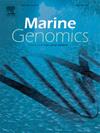Complete genome sequencing and analysis revealing assimilatory nitrate reduction pathway of a novel Sphingosinithalassobacter species isolated from the Atlantic hydrothermal sulfides
IF 1.5
4区 生物学
Q4 GENETICS & HEREDITY
引用次数: 0
Abstract
The genus Sphingosinithalassobacter comprises marine bacteria species, that notable for their versatile metabolic capabilities. However, their specific roles in nitrogen transformation pathways are largely unexplored. In this study, we present the complete genome sequencing and comprehensive analysis of Sphingosinithalassobacter sp. LHW66–3, a novel strain isolated from Atlantic hydrothermal sulfides. The strain possesses a 3.23 Mb circular chromosome with a GC content of 66.84 % and encodes 3140 predicted protein-coding genes. Phylogenetic analysis based on 16S rRNA gene sequences revealed the highest similarity (97.09 %) to Sphingosinithalassobacter portus FM6T. Furthermore, an Average Nucleotide Identity (ANI) value of <77.3 % confirms its designation as a novel species within the genus Sphingosinithalassobacter. Unlike Sphingosinithalassobacter portus FM6T, which possesses hcaD, mhpA, and pcaC genes for aromatic compound degradation, strain LHW66–3 was found to harbor a complete assimilatory nitrate reduction pathway. This pathway includes NasA (nitrate reductase) and NirD and NirB (nitrite reductase), facilitating the conversion of nitrate to ammonium. Additionally, GlnD displays the ability to senses cellular nitrogen status through glutamine availability, regulating P-II proteins (GlnK and GlnB) and the NtrB-NtrC two-component system to modulate external ammonium uptake. Furthermore, the strain shows the potential to utilizes AmtB to import ammonium, which is assimilated via the GS-GOGAT pathway: GlnA synthesizes glutamine, and GltBD converts it to glutamate. This study expands our understanding of nitrogen utilization by Sphingosinithalassobacter sp. LHW66–3 in hydrothermal environments. Furthermore, its complete assimilatory nitrate reduction pathway highlights the applied potential for nitrogen removal in intensive aquaculture systems.
从大西洋热液硫化物中分离的一种新的Sphingosinithalassobacter物种的全基因组测序和分析揭示了同化硝酸盐还原途径
Sphingosinithalassobacter属由海洋细菌种类组成,以其多种代谢能力而闻名。然而,它们在氮转化途径中的具体作用在很大程度上尚未被探索。本研究对大西洋热液硫化物中分离的Sphingosinithalassobacter sp. LHW66-3进行了全基因组测序和综合分析。该菌株拥有一条3.23 Mb的环状染色体,GC含量为66.84%,可编码3140个预测蛋白编码基因。基于16S rRNA基因序列的系统发育分析显示,该菌株与Sphingosinithalassobacter portus FM6T的相似性最高(97.09%)。此外,77.3%的平均核苷酸同一性(ANI)值证实它是Sphingosinithalassobacter属的新种。与Sphingosinithalassobacter portus FM6T不同,菌株LHW66-3具有完整的同化硝酸盐还原途径,而FM6T具有hcaD、mhpA和pcaC降解芳香族化合物的基因。该途径包括NasA(硝酸还原酶)和NirD和NirB(亚硝酸盐还原酶),促进硝酸盐转化为铵。此外,GlnD通过谷氨酰胺可用性感知细胞氮状态,调节P-II蛋白(GlnK和GlnB)和NtrB-NtrC双组分系统调节外部铵吸收。此外,该菌株显示出利用AmtB进口铵的潜力,铵通过GS-GOGAT途径被同化:GlnA合成谷氨酰胺,GltBD将其转化为谷氨酸。本研究扩大了我们对Sphingosinithalassobacter sp. LHW66-3在热液环境中对氮的利用的认识。此外,其完整的同化硝酸还原途径突出了在集约化水产养殖系统中除氮的应用潜力。
本文章由计算机程序翻译,如有差异,请以英文原文为准。
求助全文
约1分钟内获得全文
求助全文
来源期刊

Marine genomics
生物-遗传学
CiteScore
3.60
自引率
5.30%
发文量
50
审稿时长
29 days
期刊介绍:
The journal publishes papers on all functional and evolutionary aspects of genes, chromatin, chromosomes and (meta)genomes of marine (and freshwater) organisms. It deals with new genome-enabled insights into the broader framework of environmental science. Topics within the scope of this journal include:
• Population genomics and ecology
• Evolutionary and developmental genomics
• Comparative genomics
• Metagenomics
• Environmental genomics
• Systems biology
More specific topics include: geographic and phylogenomic characterization of aquatic organisms, metabolic capacities and pathways of organisms and communities, biogeochemical cycles, genomics and integrative approaches applied to microbial ecology including (meta)transcriptomics and (meta)proteomics, tracking of infectious diseases, environmental stress, global climate change and ecosystem modelling.
 求助内容:
求助内容: 应助结果提醒方式:
应助结果提醒方式:


